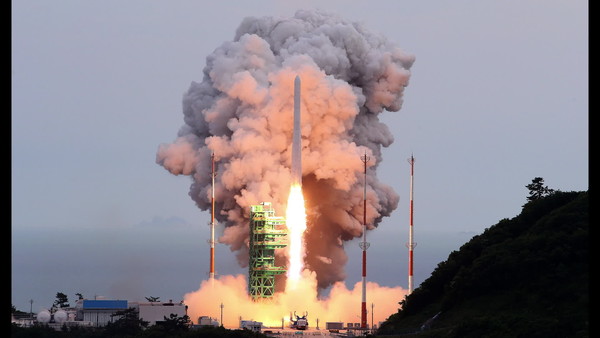
Nuri, officially named the Korea Space Launch Vehicle-II (KSLV-II), was reported to successfully launch and detach loaded satellites into desired orbits at 6:24 p.m. on May 25. This was the third launch of the vehicle, following the first launch on October 12, 2021, resulting in failure but succeeding in the second launch on June 21, 2022. For this launch, KAIST Satellite Technology Research Center (SaTReC) developed and attached Next Generation Satellite and Commodities Spacecraft (NEXTSat) 2 on Nuri, which aims to use its synthetic-aperture radar (SAR) image antennas to observe the Earth as well as cosmic radiation and storms.
With the achievement of being the first fully domestically developed launch vehicle, Nuri was developed with a total budget of approximately 2 trillion KRW and the commitment of 500 workers from 300 domestic companies over the last 12 years. The biggest difference between Naro (KSLV-I) — which was launched from 2009 to 2013 — and Nuri is that the engine of the former vehicle utilized Russian technology, while that of the latter was made with Korea’s own technology. The project of Nuri is planned to continue throughout the sixth launch; the fourth launch is expected to happen in 2025 with the next-generation middle-sized satellite.
The initial launch of Nuri was scheduled to be at 6:24 p.m. on May 24, but had been postponed due to communication errors which occurred during the control process of the supply valve of low temperature helium. The relaunch of Nuri happened one day after the postponement. After it passed the Max-Q, the point for the launch vehicle to experience maximum pressure in the surrounding atmosphere, all of the detached satellites were reported to successfully place in orbits and Nuri finished its flight of 1,138 seconds. The Department of Aerospace Engineering hosted an event where students gathered to watch the live video of the launch with the professors.
Munki Kim, a senior researcher at Korea Aerospace Research Institution (KARI) who participated in the development of a rocket engine for the Nuri, said, “This third launch of Nuri was a very significant step in our project because there was a burden to increase reliability in our launch vehicle technology as it was a successive event of the failure of the first and success of the second launch of Nuri. When I heard the news about the success, I was very happy with a sense of accomplishment that I contributed as a member to this remarkable project. I also hope this becomes a great motive for the researchers to develop improved launch vehicles for future launches.”

